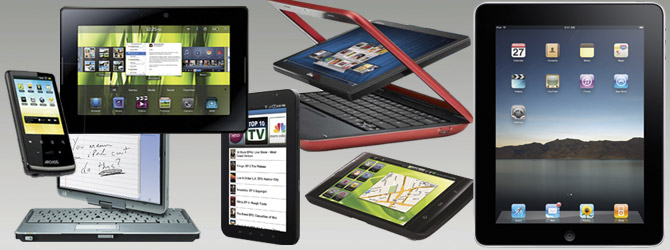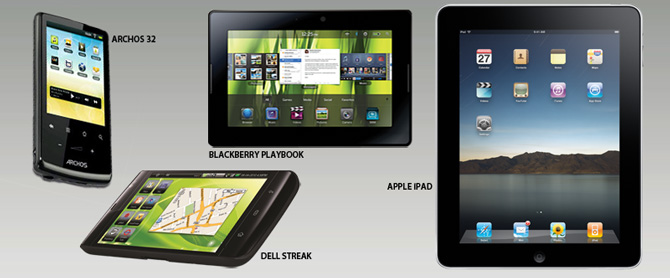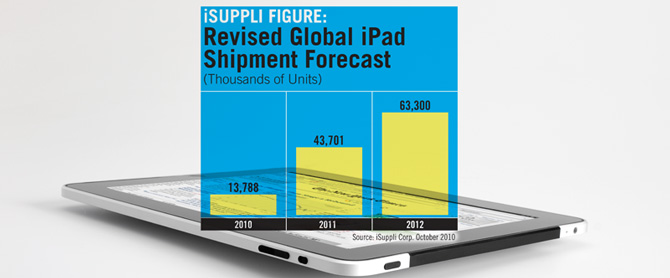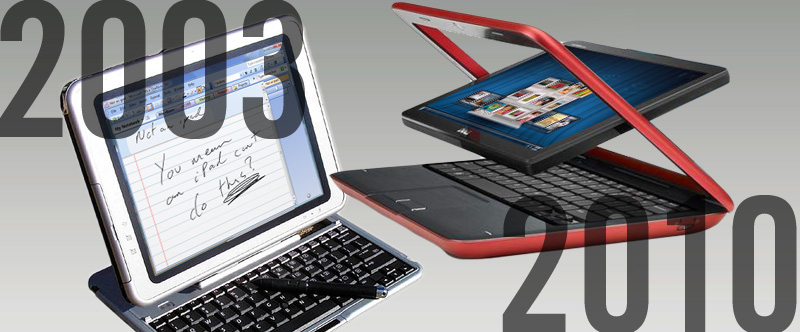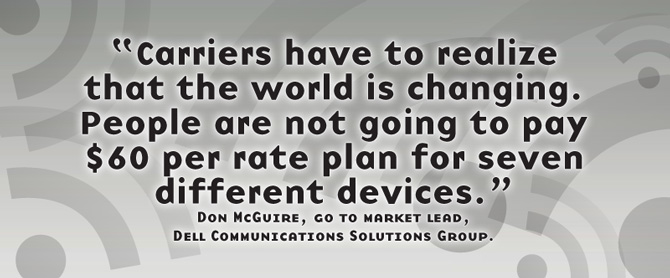What’s Next for Tablets?
You see them on planes, trains, and buses. In coffee shops and in living rooms. On college campuses and in conference rooms. Almost everywhere you turn these days, there’s a tablet. To be a little more specific, you see Apple’s “tablet,” a word the company goes out of its way not to use when describing the iPad. And who could blame them, given that the device has single-handedly revived a category Microsoft failed to make relevant to the masses?
This year iSuppli estimates that Apple will sell nearly 13 million iPads, compared with 2 million tablets sold overall last year. In fact, Apple sold that many units in July alone. From its instant-on OS and epic battery life to its unparalleled App Store, the iPad has already made such an enormous impact since its April launch that it’s cannibalizing sales of netbooks by 50 percent and laptops by 13 percent. The total number of tablets sold will mushroom to 17.5 million in 2010, and iSuppli is looking at 81.6 million slates shipped by 2012.
Of course, Apple won’t be the only company contributing to this meteoric rise. Hoping to capitalize on the iPad’s momentum, everyone from smart phone makers to PC manufacturers (and some companies you’ve never heard of) are lining up to entice shoppers this holiday season and beyond with modern-day tablets of their own. Some of these products attempt to beat the iPad on features, design, or price, or all of the above.
Sure, there are plenty of Apple alternatives that look good on paper. But there are also a lot of unanswered questions, including what defines a good tablet in 2010—not to mention a tablet in general—how soon can Android or anyone else close the gap with Apple’s iOS, and whether it’s worth it to buy a shiny, new tablet with 3G inside or go the Wi-Fi-only route. What’s next for tablets? This is your guide.
What’s a Tablet, and What’s Not
In case you hadn’t noticed, smart phones are getting bigger. It’s now common to find devices from all the major carriers with 4- to 4.3-inch displays. However, you won’t find many models above that range for a reason. “When you get past 4.5 inches on a handset you really struggle from a pocketability and comfort level,” said David Owens, vice president of marketing for Sprint. “You struggle on the tablet side until you get to 7 inches, where people feel comfortable with the device as a PC replacement.”
While there’s plenty of room for debate as to whether a tablet could, or should, replace a full PC, the industry seems to have more or less conflated on the definition of a tablet. Most of these devices sport a slate-style design with 7- to 10-inch displays and are primarily geared toward consuming content, whether it’s apps, books, games, movies, or websites. Dell labels its 5-inch Streak a tablet, but it’s too small to be called that and too big to use as a phone. “It really is a tweener,” said Rhoda Alexander, director of monitor research at iSuppli. Meanwhile, Archos offers “tablets” as small as 2.8 inches, but they’re more like portable media players with web browsers.
Sign up to receive The Snapshot, a free special dispatch from Laptop Mag, in your inbox.
As to whether 7 or 10 inches is better (the iPad is 9.7), it really depends on how much you care about portability versus screen real estate. The 7-inch Galaxy Tab, for example, is compact enough to slip into a coat pocket, but not your jeans. Samsung claims it’s also easier to type on than the iPad. “The keyboard location is perfect for thumb typing because of the width,” said Gavin Kim, vice president of content and data services for Samsung Mobile. Then again, the iPad is certainly more mobile than a netbook, and its larger display makes it easier to read websites, magazines, and other content.
When it comes to software, modern tablets tend to run a mobile operating system such as Apple’s iOS or Google’s Android. RIM will enter the market early next year with its 7-inch PlayBook (running on the QNX OS it recently purchased), and HP will ship a webOS-based tablet likely called the PalmPad. Microsoft isn’t giving up on slates powered by full Windows, but there’s a reason why the company has also rolled out a variant of Windows CE for slates called Windows Compact 7 Embedded. The masses have already voted with their wallets that more nimble and efficient platforms will rule.
How Apple Changed the Game
And that brings us to the biggest differences between the iPad and tablets that came before it. It isn’t that Apple just lopped off the keyboard. The company redefined the user experience, resuscitating a category many had assumed would forever remain a niche device for doctors, field workers, and others who wanted to use a stylus for input. Helping to drive the point home that this was not your father’s tablet, Apple gave the stylus the heave-ho in favor of an all-multitouch interface. More important, Apple didn’t use a desktop OS.
“Apple went with a mobile operating system, which really changed the playing field, because you could have an instant-on device,” said Alexander. The result was a device that you pick up and start using immediately, which makes a huge difference for those who want to update their Facebook or Twitter status, play games, or read digital books or magazines—no boot time required. Because Apple paired its iOS with its power-efficient A4 chip, that instant gratification can last up to 10 hours on a charge. Most touch-enabled Windows tablets we’ve reviewed don’t last half as long.
Another key ingredient for the iPad’s success has been its App Store, which stocks more than 35,000 apps designed for its high-resolution display. Apple’s more than 300,000 iPhone apps will run on the device, but they don’t look nearly as good, because you have to stretch them to fill the screen.
How important are apps? Toshiba, which recently launched an Android tablet for the European market, decided to delay the product for the U.S. until there was a sufficient tablet app ecosystem. “Here in the U.S.—given the iPhone, iPad, and Android smart phones—there’s a very strong expectation of access to apps and using apps,” said Chris Casper, group manager at Toshiba. “There’s an expectation that you are going to be able to access the same type of apps as on your smart phone.” Turns out Europeans like apps, too. The device was recently pulled from some UK stores.
The (Next) Android Invasion
By our count, there will be at least a dozen Android tablets for sale by early 2011, with everyone from ASUS and Dell to Samsung and ViewSonic betting on Google’s open platform. There’s just one tiny roadblock. Google doesn’t believe its OS is quite ready for big-screen devices. In fact, the director of products for mobile at Google, Hugo Barra, said in September that “Froyo is not optimized for tablets.”
Barra was referring to the latest version of the OS that Google designed for smart phones. Later versions of Android (i.e., Gingerbread, but particularly Honeycomb) will reportedly be built with tablets in mind and are expected to launch early next year. “Right now if you’re an application provider in the Android world, you’re looking at a mix of screen resolutions and sizes, and a mix of Android platforms,” said Alexander. Because Android supposedly isn’t yet ready for prime time, both LG and Motorola are waiting to launch their slates until 2011.
However, this sentiment isn’t stopping the intrepid from optimizing the current version of Android themselves. Although Samsung admits that its Galaxy Tab is slightly ahead of the curve in terms of developers offering tablet-friendly Android apps, the device will access the Android Market. Samsung also stresses that it has done a lot of its own work in making the OS a better fit for tablets, from its Media Hub store for movie and TV show downloads to split-screen interfaces for the Galaxy Tab’s contacts, calendar, messaging, social networking, and other apps. “We have done custom plumbing, which specifically allows us to deliver the experience that we want,” said Kim.
Other iPad competitors going the Android route are circumventing Google’s objections by bundling their own app stores. All of Archos’ five tablets (yes, five) have its proprietary AppsLib store preloaded. The company says AppsLib stocks more than 5,000 free and paid apps, and that it will preload certain apps on its tablets to get users started. For example, the 10-inch Archos 101 will come with the Fring video chat application to take advantage of the device’s front-facing camera, a feature the iPad currently lacks.
Still other Android tablets will differentiate based on features alone, such as the ViewSonic G-Tablet. Its dual-core Nvidia Tegra 2 processor and high-powered graphics provide 1080p video playback (Apple’s tablet maxes out at 720p), enhanced gameplay, and plenty of multitasking muscle. “Certainly the graphics capability is going to be pretty astounding, and having dual-core processors enables more content and better performance,” said Matt Wuebbling, director of product marketing for mobile business at Nvidia.
According to Ross Rubin, executive director of industry analysis at NPD, Android tablets are poised to gain momentum, but he agrees with Google’s own Barra about Android not yet being fully baked for slates when compared to iOS. “Lower-priced competitors, particularly driven via extensive carrier subsidization, could enable competitors to eat into Apple’s share,” Rubin said. “However, the other OS ecosystems are not ready yet.”
What About Windows?
Back in 2001 Microsoft promised to revolutionize mobile computing with its Tablet PC platform. A digital pen was the key to increased productivity and a wave of new programs that would benefit from this new input method. As it turned out, very few consumers were interested in spending more for this versatility, and Microsoft’s tablets never evolved beyond a tool for vertical industries and (some) well-heeled students.
Fast forward to the launch of Windows 7 in late 2009, when Microsoft touted touch capability as one of the features of its new OS. A few months later at the Consumer Electronics Show, Microsoft CEO Steve Ballmer waved the heavily hyped HP Slate during his keynote address, only for the company to relegate it to an enterprise-only product and gobble up Palm’s webOS instead.
The problem isn’t that people don’t like Windows; it just wasn’t designed for instant-on mobile devices with long battery life, despite the fact that Ballmer has characterized tablets as PCs merely with a different form factor. “When Apple came out so strong out of the gate, all of a sudden everybody went back to the drawing board,” said Alexander. “So most of the plans for Windows-based devices were scrapped and people started working on plans for mobile-based devices.”
As the iPad enters its eighth full month on the market, Microsoft and its partners are still in the beginning stages of a tablet comeback. A company spokesperson told us, “we see slates as an opportunity to expand the PC market and create choice for customers. We’re working with our hardware partners to bring the full value of Windows to new slate designs.” And not all of these devices will look like slates as we know them. The innovative Dell Inspiron Duo convertible has a display that flips around inside the bezel, so you don’t need to worry about messing with a fussy hinge.
Still, even with a power-sipping Atom processor under the hood, most of these Windows tablets will muster only 4 to 5 hours of battery life, and they won’t turn on instantly like the iPad. That’s why Microsoft is hedging its tablet bet with Windows Embedded Compact 7, which is based on Windows CE and is optimized for media playback and touch interfaces.
Despite the challenges facing Microsoft in the tablet arena, such partners as Toshiba see a place for traditional Windows. “For certain devices an embedded OS is the right way to go, and for others, a more PC-like experience is the way to go,” said Toshiba’s Casper. “A Windows 7 tablet is a PC, right? And you’ve got full access to all of the applications that are on a PC, so having an app store isn’t necessarily an issue.”
3G vs. Wi-Fi
Last year when you walked into a carrier store, Best Buy or Radio Shack, you probably saw at least one or two netbooks with built-in mobile broadband being dangled for $99 or less. The catch? A $59-per-month data plan and two-year contract, ballooning the price tag of that “low-cost” mini-laptop above $1,500. As you might expect, most consumers didn’t bite, deciding instead to stick with Wi-Fi-only netbooks that start at $299.
“Carriers have to realize that the world is changing,” said Don McGuire, go to market lead, Dell Communications Solutions Group. “People are not going to pay $60 per rate plan for seven different devices. It’s not going to happen.” McGuire says that Europe is much further along than the U.S. when it comes to thinking outside of the traditional subsidy model.
AT&T took a risk with the Wi-Fi + 3G version of the iPad by deciding not to discount the hardware. However, while the tablet itself costs a relatively steep $629, the data plan is $25 for 2GB per month (and $14.99 for 250MB). Plus, you don’t have to sign a contract; you just turn the data on when you want to and pay for that month’s service. According to a recent iPad owner survey, about half of those purchased a 3G model. Ultimately, carriers will have to be even more flexible if they want tablet shoppers to pay for the convenience of mobile broadband.
“All of us are trying to figure out what’s the right price point, what’s the usage, and how often are users connecting,” said Sprint’s Owens, one of four carriers selling Samsung’s Galaxy Tab. Sprint’s version costs $399 with a two-year contract and a $29-per-month 2GB data plan. A 5GB plan costs $59 per month. An unsubsidized model costs $599 with the same data plan options. Other carriers charge between $399 to $649 for the device, and offer a wide range of data plans. Verizon Wireless, for example, sells Samsung’s slate with 1GB ($20), 3GB ($35), and 5GB ($50) plans.
As carriers and tablet makers continue to solve this puzzle, Wi-Fi-only tablets will predominate in the short term. However, slates with mobile broadband baked in should eventually take off. “As the cost of the hardware starts coming down and next-generation 4G networks start to expand, having that capability is going to be more attractive over time,” said Toshiba’s Casper.
The Future of Computing
When you think about everything a tablet can do today, it’s no surprise that an increasing number of workers are leaving their laptops behind. “People are now walking into meetings with tablets. And the portability of tablets makes it a big opportunity,” said Sprint’s Owens. “I see it being a prosumer tool. I can use it for productivity, and I keep it with me for the entertainment side of it. It’s become a substitute for my phone as well as my PC.”
On the other hand, with their more powerful processors, physical keyboards, and gobs of onboard storage, traditional notebooks are much better for creating rather than consuming content. In other words, the death of the PC has been greatly exaggerated. “We see a rush of early adopters and the curious buying an incremental device that they wouldn’t have bought otherwise, because it’s cool,” said Stephen Baker, vice president of industry analysis for NPD.
The truth about tablets really lies somewhere in the middle. The iPad isn’t just cool. It has changed the way consumers and other big consumer electronics players think about what computers are and what they can do. And while they don’t pose an immediate threat to laptops, tablets are gaining capabilities so rapidly that more and more people will think twice about whether they need to tote that clamshell. Because the market is still so new, there’s plenty of opportunity for the category to evolve in multiple directions. And that includes players other than Apple.
“I think the opportunity that Microsoft and others still have in the tablet market is that these devices that have been so popular of late are really consumption devices,” said Alexander. “I think there is still room for a lot of competition in creation-focused devices. Tablet makers are coming out with competitive products much more quickly.”
Apple won’t be twiddling its thumbs as competing devices emerge, either. The company is rolling out an update for the iPad that allows full multitasking, folders (for better organizing your apps), and streaming of music and video wirelessly to compatible accessories, including the Apple TV. Plus, there’s Game Center, a gaming social network that only further advances Apple’s lead in that category. Add up all of these advantages, as well as expected hardware sequels, and it’s easy to see why iSuppli forecasts a still-dominant 66 percent tablet market share for Apple in 2012, down from 84 percent this year.
So it’s game over for everyone else, right? Not if you ask the flood of companies backing Google’s Android OS for a tablet counterattack.

